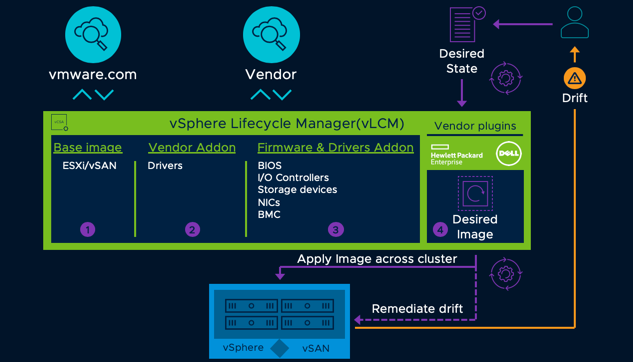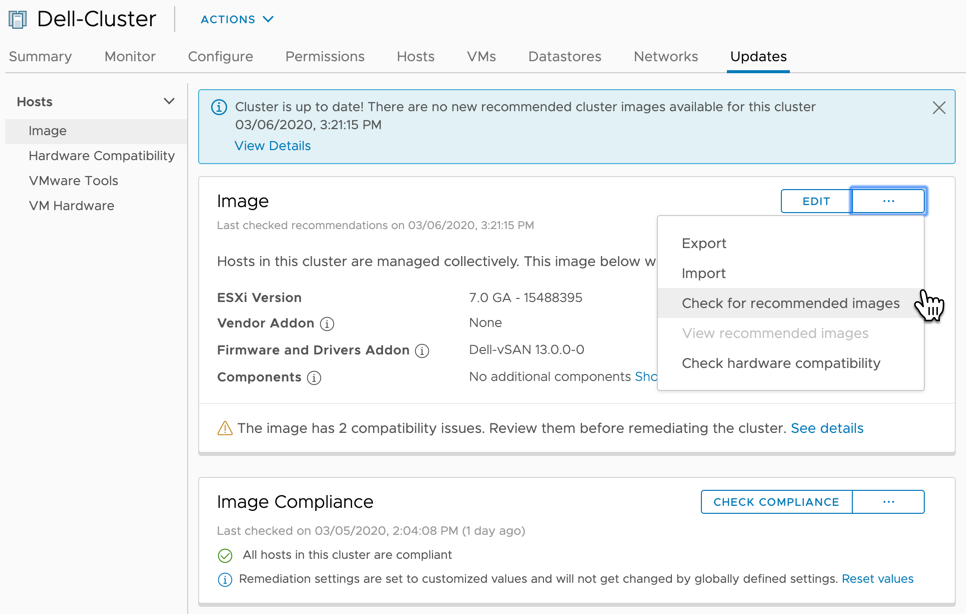Lovin' the updates - vLCM
Updates! Everyone loves an update or two...... ok, maybe I've overstated things here a little. The problem with udpates is that they are never ending, can be quite disruptive, and you can very quickly run into issues with compatibility matrixs and support if you're not careful. Anyone who manages virtual infrastructure will be well aware of the complexities of keeping all the different components aligned and in a supported configuration particularly when multiple vendors are involved. And then we have to manage configuration drift across your fleet of hosts....

To the rescue with vSphere 7 we have the introduction of the next generation of VMware Update Manager (VUM) in the form of vSphere Lifecycle Manager (vLCM). vLCM moves away from simply managing the vSphere hypervisor itself and jumps directly to managing your cluster as a whole. This declarative model allows you to define your own cluster image, including vendor addons and even push firmware updates to the underlying hardware! Sound better than manually downloading custom ISO images from multiple vendors? Have you checked your hosts against the HCL (VMware Hardware Compatibility List) lately......not to worry, vLCM will take care of that as well!

Like most things there are some prerequisites and caveats so lets deal with these first......vLCM Requirements and Specifics
Prereqs/Caveats:
- All ESXi hosts in the cluster must be of version 7.0 and later
- All ESXi hosts in the cluster must be stateful
- All ESXi hosts in the cluster must be from the same vendor
- Each cluster requires a one time (non-reversible) switch from using baselines (VUM) to images (vCLM)
- No host in the cluster can contain any unknown components
If you currently have clusters with hosts from multiple vendors then this means some restructuring on your part before you can start.... new clusters anyone? Obviously the features were only introduced with vSphere 7 and then enhanced again with update 1 (including support for NSX-T v3.1) so your hosts will need to be relatively current as well.
The Components:
There are four main components of the vCLM solution.
- Cluster image
- ESXi version
- Vendor Addons
- Firmware & Drivers

Cluster Image
The basis of vLCM is its declarative/desired state Cluster Image. Here you define each image based on ESXi version, Hardware vendor, and optionally Firmware/Drivers and additional components. One image per cluster. In the example below we have a cluster running Dell PowerEdge servers, ESXi 7.0b and and optional component which in this case is the Dell Service Module.

Vendor Addons
This is where you select the vendor specific addons for your image. There are a number of supported vendors here including: NEC, Lenovo, HPE, Fujitsu, DellEMC, and Cisco. vLCM will automagically download the special sauce required from your hardware vendor (including hardware providers and drivers). Note, these are version specific (ESXi) and are slipstreamed directly into your cluster image.
Full Stack Firmware Updates
The Rolls Royce solution gives you the abiltiy to perform firmware directly from the vSphere Client. In order to do this you need a whats called a Hardware Support Manager (HSM). These generally come in the form of an OVF image from your Hardware vendor and integrate directly with vLCM. Currently, there are only three vendor supported HSM's. Dell have OMIVV or OpenManage Integration for VMware vCenter, HPE have HP ILO Amplifer and now Lenovo have XClarity Integrator - depending on your vendor these may require a license.
Image Management
Bringing these all together gives the VMware administrator a simplified method to manage and monitor critical components like vSphere version, firmware, and drivers. Not quite the proverbial SPOG or Single Pane of Glass but a pretty damn good start! Cluster wide drift detection is simply a matter of checking image compliance and remediating can be controlled manually or fully automated if required. Image upgrades are handled the same way, update the cluster image (e.g. new ESXi version and Vendor Addon), valiate it, and save your changes. Note - updating your image only changes your desired state. You then check compliance against this state and remediate non-compliant components when ready. Remediation will be performed in a non disruptive fashion just as the legacy VUM does. vLCM also checks hardware compatibility against the VMware Hardware Compatibility List (HCL) thus reducing risk of unsupported drivers or firmware version conflicts.

Additionally, vLCM will check for available updates for the cluster image and make recommendations based on the current cluster components.

Definately an evolutionary step from the old VUM and something that promises to make managing larger scale clusters a lot easier. We do have an upgrade to vSphere 7 on the roadmap this coming year for our IaaS clusters and this is just one of the new features I'm looking forward to.
